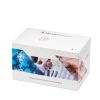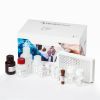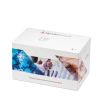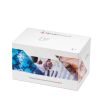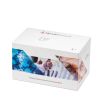FHR-4, Human, ELISA kit – 2 x 96 det. - HK3006-02
Catalog #
HK3006-02
1.359,00 €
Human full-length Complement Factor H-related protein 4 (FHR-4) is a glycoprotein that is part of the complement regulatory protein family. It is synthesized and secreted primarily by the liver, as well as immune cells such as monocytes, macrophages, and dendritic cells. Unique among the FHR proteins, FHR-4 has two splice variants: FHR-4A, a longer protein with an approximate molecular weight of 86 kDa composed of 9 short consensus repeats (SCR) domains, and FHR-4B, a shorter protein of around 42 kDa with 5 SCR domains. The ELISA recognizes both variants, FHR-4A and FHR-4B.
Structurally, FHR-4, Human, shares homology with Complement Factor H (CFH), a key regulator within the complement system. FHR-4 operates within the complement regulatory network, particularly affecting the alternative pathway of the complement system. It binds C3b, thereby participating in the regulation of alternative pathway activation. FHR-4 also plays a role in the opsonization of necrotic cells, facilitating the binding and recruitment of CRP. Elevated systemic levels of FHR-4 have been strongly associated with age-related macular degeneration (AMD). However, studies have also reported inconclusive or contradictory results regarding the involvement of FHR-4 in AMD. This ambiguity highlights the need for further research to clarify FHR-4's role in AMD and potentially other diseases. FHR-4's unique structural properties and its diverse biological functions emphasize its significance in the complement system and its potential as a target for therapeutic interventions.
FHR-4 can be measured with our HK3006 assay, designed to precisely quantify this intriguing glycoprotein.
Structurally, FHR-4, Human, shares homology with Complement Factor H (CFH), a key regulator within the complement system. FHR-4 operates within the complement regulatory network, particularly affecting the alternative pathway of the complement system. It binds C3b, thereby participating in the regulation of alternative pathway activation. FHR-4 also plays a role in the opsonization of necrotic cells, facilitating the binding and recruitment of CRP. Elevated systemic levels of FHR-4 have been strongly associated with age-related macular degeneration (AMD). However, studies have also reported inconclusive or contradictory results regarding the involvement of FHR-4 in AMD. This ambiguity highlights the need for further research to clarify FHR-4's role in AMD and potentially other diseases. FHR-4's unique structural properties and its diverse biological functions emphasize its significance in the complement system and its potential as a target for therapeutic interventions.
FHR-4 can be measured with our HK3006 assay, designed to precisely quantify this intriguing glycoprotein.
| Datasheet URL | https://www.hycultbiotech.com/wp-content/uploads/2024/03/HK3006-0324.pdf |
|---|---|
| Quantity | 2x96det. |
| Working volume | 100 µl/well |
| Species | human |
| Cross reactivity | Monkey - Yes, Mouse - No, Pig - No, Rat - No |
| Alias | Complement Factor H-related protein 4 |
| Principle | The human FHR-4 ELISA is a ready-to-use solid-phase enzyme-linked immunosorbent assay based on the sandwich principle with a working time of 1 hour and 15 minutes. The efficient format of a plate with twelve disposable 8-well strips allows free choice of batch size for the assay. Samples and standards are incubated in microtiter wells coated with antibodies recognizing human FHR-4. Peroxidase-conjugated antibody will bind to the captured FHR-4. Peroxidase-conjugate will react with the substrate, tetramethylbenzidine (TMB). The enzyme reaction is stopped by the addition of oxalic acid. The absorbance at 450 nm is measured with a spectrophotometer. A standard curve is obtained by plotting the absorbance (linear) versus the corresponding concentrations of the human FHR-4 standards (log). The human FHR-4 concentration of samples, which are run concurrently with the standards, can be determined from the standard curve. |
| Storage and stability | Product should be stored at 4 °C. Under recommended storage conditions, product is stable for at least six months. |
| Precautions | For research use only. Not for use in or on humans or animals or for diagnostics. It is the responsibility of the user to comply with all local/state and federal rules in the use of this product. Hycult Biotech is not responsible for any patent infringements that might result from the use or derivation of this product. |
| Disease | Autoimmunity, Infectious diseases, Nephrology, Tumor immunology |
| Principle: | The human FHR-4 ELISA is a ready-to-use solid-phase enzyme-linked immunosorbent assay based on the sandwich principle with a working time of 1 hour and 15 minutes. The efficient format of a plate with twelve disposable 8-well strips allows free choice of batch size for the assay. Samples and standards are incubated in microtiter wells coated with antibodies recognizing human FHR-4. Peroxidase-conjugated antibody will bind to the captured FHR-4. Peroxidase-conjugate will react with the substrate, tetramethylbenzidine (TMB). The enzyme reaction is stopped by the addition of oxalic acid. The absorbance at 450 nm is measured with a spectrophotometer. A standard curve is obtained by plotting the absorbance (linear) versus the corresponding concentrations of the human FHR-4 standards (log). The human FHR-4 concentration of samples, which are run concurrently with the standards, can be determined from the standard curve. |
|---|



